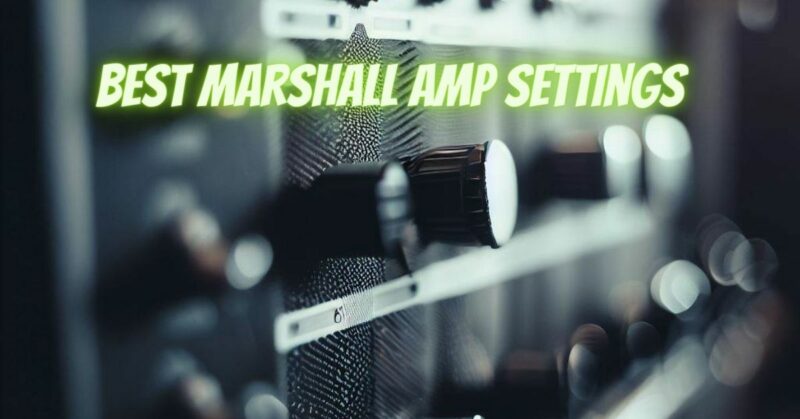Marshall amplifiers are synonymous with legendary rock and roll sounds, and finding the best settings for your Marshall amp is essential to achieve your ideal tone. Whether you play blues, rock, metal, or any other genre, dialing in the perfect settings can make a significant difference in your sound. In this article, we will provide a comprehensive guide to help you discover the best Marshall amp settings to suit your playing style and musical preferences.
- Start with a Clean Slate
Before diving into specific settings, reset your amp’s controls to their neutral or default positions. This will provide a clean slate to build your tone from scratch.
- Select Your Desired Amp Model
Marshall offers a wide range of amp models, each with its unique characteristics. Choose an amp model that complements your musical style. For example, vintage-style amps like the Plexi or Bluesbreaker are ideal for classic rock and blues, while high-gain models like the JVM or DSL series are better suited for metal and hard rock.
- Set the Channel and Gain
Select the appropriate channel on your amp that aligns with your intended sound. If you desire a clean tone, use the clean channel. For overdriven or distorted tones, switch to the lead or overdrive channel. Adjust the gain (or volume) control to achieve the desired level of overdrive or distortion.
- Shape Your EQ
The EQ controls on your Marshall amp include bass, middle, treble, and sometimes presence. Here are some general guidelines for shaping your EQ:
- For a warmer, vintage tone: Boost the bass and treble slightly and set the middle at a moderate level.
- For a scooped, modern sound: Boost the bass and treble significantly, and reduce the middle to create a scooped midrange.
- For a balanced, versatile tone: Set all EQ controls at a neutral or moderate level.
Remember that EQ settings are subjective and depend on personal preference and the tone you’re trying to achieve. Experiment with the controls until you find the sweet spot that best suits your playing style.
- Adjust the Presence and Resonance (if available)
The Presence control affects the high-frequency response, adding or reducing brightness. The Resonance control adjusts the low-end response, tightening or loosening the bass frequencies. Use these controls to fine-tune your tone and shape the overall sound of your amp.
- Experiment with Power Tube Bias (if applicable)
If your Marshall amp allows bias adjustment, you can experiment with different bias settings to alter the response and feel of your amp. A “colder” bias setting can provide a tighter, more focused sound, while a “hotter” bias setting can result in a smoother, more saturated tone.
- Utilize Your Guitar’s Controls
Don’t forget the powerful tone-shaping capabilities of your guitar’s volume and tone controls. Rolling back the volume can clean up your sound, while adjusting the tone knob can tame or brighten your tone to suit different playing situations.
- Use Pedals to Enhance, Not Mask
While Marshall amps are known for their natural overdrive, using pedals can be beneficial to enhance your sound. Consider using pedals like overdrives, boosts, delays, and reverbs to add depth and versatility to your tone. However, avoid relying heavily on pedals to cover up inadequacies in your amp’s settings.
- Trust Your Ears
Ultimately, the best Marshall amp settings are the ones that sound best to your ears. Trust your instincts and make adjustments based on what you like to hear. Every amp and guitar combination is unique, so don’t be afraid to experiment and find your own signature tone.
Finding the best Marshall amp settings requires a combination of technical knowledge, experimentation, and a keen ear. Start with a clean slate, choose the appropriate amp model, and shape your tone using the EQ, presence, and resonance controls. Don’t forget to utilize your guitar’s controls and explore the possibilities of bias adjustment if available. Finally, use pedals sparingly to enhance, not mask, your natural amp sound.
Remember, the best settings are subjective and depend on your playing style and musical preferences. With dedication and persistence, you can discover the perfect Marshall amp settings that suit your unique sound, helping you unleash your full potential as a guitarist and deliver a performance that leaves a lasting impact on your audience. Rock on!

